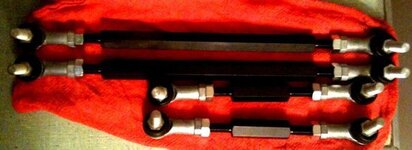Aren't the balls in the first post rated to 3900 lbs?
You're referencing the material Strength of Yielding Point (tensile*) and you're looking at the M6 size. The M10 (which I assume MP3me bought as that's stock size) is rated at 11300 N (Pk)
As such, they're rated in metric units (Newtons) and you'd have to convert to ANSI standard (lbf)
Thus, given 11300 N (Pk), which kgf = N0.101972 = 11300 x .101972 = 1152.28 kgf
Thus 1 kgf = 2.2 lbf, so 1152.28 kgf x 2.2. = 2535.02 lbf (comparable to 2036 lbf of the ones I purchased)
Now moving on to the forces themselves, the Misumi M10 bearing is specing out static radial (which isn't the same as the axial) load and would be 4105.39 lbf (as my axial pull out is "only" 1302 lbf)
(someone can double check my math)
That said, we end up comparing apple forces to orange forces. Axial forces run parallel or "through" the ball/stud - trying to pull the ball out of its bearing races - while radial load is orthogonal (90o) to the stud - forcing loads "through" the bearing itself...
In addition, we end up talking about the difference between static and dynamic loads (and not even taking into account any degrees of misalignment at any given point in the linkage cycle)
If just going off static loads, one would need to to convert axial to radial which I know can be determined, I just don't have the wherewithal/machinery handbook to take up at the moment....
So which are better? Not sure; higher numbers are arguably better, but I there's also a cost/benefit that one must evaluate as well as each person's suspension setups and driving demands.
see all this hex rod business is great but, still happy with with my stainless rods i got for free from a friend lol. they aren't all super shiney but they will take like 20x the weight of my car in stress before they break.
Generically speaking, stainless' tensile* rating isn't all that strong (it's actually pretty brittle). Not all stainless is the same and yield strength generally increases in higher 300 or 400 series (along with them being tempered or not, etc, etc)
Do you know what stainless alloy the rods are?Not saying that you're going to shear them, just saying that promoting carbon steel to 'stainless' in and of itself isn't a characteristic that improves strength.

